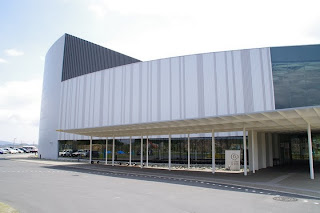My working site in Ishinomaki is Yugakukan (遊楽館). Yugakukan is situated about 7 miles inland from the coastline and a half way up on the hill. Yu (遊) means to play, gaku (楽) means to relax and kan (館) means a pavilion. It is a multipurpose community center with a swimming pool, sports arena, a concert hall (even with a pipe organ!) and several lecture/conference rooms. It must be a community gathering place filled with laughter and cheers prior to the earthquake. Now it is a quiet shelter without basketball games or pop concerts. But I do see people’s smiles are returning…
There are some, but minor structural damages from the earthquake, but electricity, water supply and sewage are all resumed and fully functional. Hot meals are prepared in the kitchen by a catering company. It even provides free WiFi connection and air-conditioning if needed.
 | |||
| Yugakukan |
 |
| My "colleagues" |
Yagakukan is categorized as a “welfare shelter”, which means a shelter that provides primary care to its residents: however, it is not a hospital. It is similar to nursing homes staffed with healthcare providers and social workers. Its residents are expected to move out when temporary housing along with home care support become available.
All the residents are housed in the arena. Its medical staffs (nurses and physical therapists) are primarily from the Ishinomaki Municipal Hospital (IMH). IMH was a 200-bed secondary and tertiary care hospital located downtown Ishinomaki City by the coast line. It was severely damaged by Tsunamis. IMH is still standing, but non-functional. To date, there is no plan to repair or restore IMH.
Yugakukan’s medical director is Dr. A., who is a cardiologist at IMH. Some of the Yugakukan residents are his patients from IMH. We are the MDs on duty (24/7) since Dr. A can come to Yugakukan only twice a week. Our main responsibilities are to stabilize (or improve) medical condition and daily activity levels of the residents. Most residents are elderly people with chronic illnesses such as hypertension, diabetes, cognitive impairment, post-stroke and post-cancer condition. Fortunately no one requires acute and intensive medical intervention beyond primary care level.
 |
| Downtown Ishinomaki with IMH in the background |
 |
| Severe damages at IMH |
Our typical day starts at 7:50 am with a volunteer briefing in our lodging. Then we depart to our work sites – MDs and RNs split to two locations including Yugakukan and mid-wives do home visits.
Our day ends around 6 pm and back to our housing. Dinner, bathing (there is a hot spa right next door to our lodging) and socializing (talk, talk, talk, often over some beer or sake – there is no TV!).
I will talk about our living quarters and our “team-bonding” in my next blog post...
(photos: courtesy of the Japan Primary Care Association, also copied from other public web sites, plus my own photos)


No comments:
Post a Comment